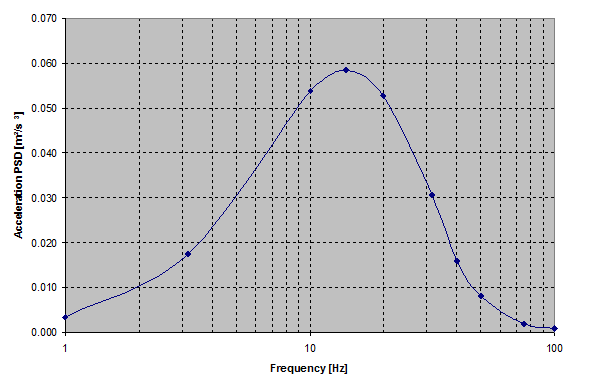Boundary conditions are considered to be fixed (zero displacements) at all degrees of freedom (DOFs) of the basemat nodes, as shown in Figure 34.3: NPP Structures FEM (Mesh Size Adapted to 50 Hz Cutoff Frequency). It is assumed that the basemat follows the free-field ground motion exactly.
The probable SDOF system peak responses (response spectrum) is related to the PSD of the input signal using the following relationship:[5]
where G is the one-sided ground-motion acceleration PSD ((m/s2)2/Hz), ξ is the damping ratio, F is the excitation frequency, Sa(F,ξ) is the acceleration response spectrum, and T0 is the earthquake duration (s).
The following acceleration PSD can be obtained assuming a 5 s duration earthquake:
The acceleration PSD is required to run a single point (coherent) PSD analysis. In the case of multiple partially coherent excitations, it is necessary to perform these additional tasks:
Calculate the participation factor pertaining to each region being used.
Calculate the direct and cross participation of each pair of regions to the overall response.
A suitable region size should be selected based on the central frequency and the spatial coherency model used. The coherence curve shown in the following figure is used to determine the minimum size of the region:
Figure 34.5: EPRI-TR 1014101 -- Plane Wave Coherency Model for Horizontal Direction

By definition, the coherence function is unity for coherent input. The figure shows that the coherence function is near unity at low frequencies (less than 5 Hz), and that it decreases with frequency and separation distance between the observations points in the free-field. A decrease in response amplitudes for high-frequency vibration modes can therefore be expected.
At a given frequency, two points experience correlated motion if the coherence value is close to unity (or approximately above 0.6).
At a frequency of 15 Hz (the peak of PSD curve), two points distant by more than 5 m would exhibit a coherency below 0.6. To be rigorous, a region size of 5 m should be used; for a 100 x 100 m square basemat, 20 x 20 = 400 regions would therefore be required. Here, a 10 m region size is used to moderate the problem size while capturing the primary phenomena.
To capture wave-passage effects, a region size smaller than the wavelength should be used. To simplify the analysis, it is assumed that the NPP is excited by a wave exhibiting a horizontally propagating direction, with the wavelength equal to:
where λ is the wavelength, Fcut is the cutoff frequency, and Cs is the soil shear wave velocity.
With a cutoff frequency of 50 Hz and a soil shear wave velocity of 3000 m/s, the resulting dominant wavelength is 60 m. Based on a minimum of six regions per wavelength, the region size is input as 10 m.



